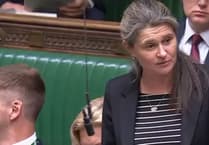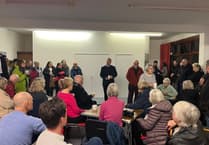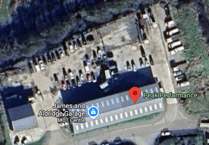The royal family grieved in public as the nation bid farewell to its Queen and watched as the late monarch left the capital for the last time.
King Charles III was left close to tears during a state funeral service at Westminster Abbey, where the Archbishop of Canterbury described the Queen as having touched “a multitude of lives” and having been a “joyful” figure for many.
The Queen was head of state but also a mother, grandmother and great-grandmother and in a personal touch, the wreath adorning her coffin had a handwritten note from the King.
The message said: “In loving and devoted memory.”
Tens of thousands of mourners lined the ceremonial procession route from the Abbey to Wellington Arch, where the Queen’s coffin left for her Berkshire home of Windsor Castle and a committal service.
Her coffin was borne on a gun carriage in a spectacle not seen for many generations, as hundreds of soldiers, sailors and airmen marched to solemn funeral pieces or lined the route.
In a moving gesture, staff from Buckingham Palace stood outside the gates of the royal residence and watched as the late monarch was taken past.
The Queen’s coffin was flanked by people she had known well, her equerries, drawn from the military to organiser her diary, and soldiers from the Queen’s Company, 1st Battalion Grenadier Guards – soldiers she personally commanded.
Behind her coffin were Charles and his siblings – the Princess Royal, Duke of York and Earl of Wessex – who were followed by the monarch’s three grandsons, Peter Phillips, Duke of Sussex and Prince of Wales.
The royal women travelled behind in state limousines with the Princess of Wales and her children George and Charlotte with the Queen Consort and the Duchess of Sussex travelling with the Countess of Wessex.
In the shadow of Apsley House, the former home of the Duke of Wellington, the sailors who had drawn the carriage carrying the Queen’s coffin came to a halt, and then the bearer party from the Queen’s Company carried it to the waiting state hearse which bean the journey to Windsor.
Around 2,000 people attended the Queen’s funeral at Westminster Abbey, including members of royal families from across Europe, politicians from all sides of the political spectrum and world leaders, including US President Joe Biden and French President Emmanuel Macron.
George and Charlotte joined the procession behind the coffin when it was carried through the Abbey and the Kate was seen putting a comforting hand on her son’s knee towards the end of service.
The state funeral clearly had an effect on royal family with the Countess of Wessex dabbing her eyes and the Queen’s granddaughter Princess Beatrice seen crying.
Justin Welby told mourners: “People of loving service are rare in any walk of life. Leaders of loving service are still rarer.
“But in all cases those who serve will be loved and remembered when those who cling to power and privileges are forgotten.
“The grief of this day – felt not only by the late Queen’s family but all round the nation, Commonwealth and world – arises from her abundant life and loving service, now gone from us.
“She was joyful, present to so many, touching a multitude of lives.”
Mr Welby, standing in the church where kings and queens have been crowned since 1066, also said that the Queen had declared on her 21st birthday “that her whole life would be dedicated to serving the nation and Commonwealth”.
He added: “Rarely has such a promise been so well kept. Few leaders receive the outpouring of love we have seen.”
Among the hymns sung at the service was The Lord’s My Shepherd, I’ll Not Want, also sung at the Queen’s wedding to the Duke of Edinburgh in the Abbey in 1947.
The other hymns were The Day Thou Gavest, Lord, Is Ended; and Love Divine, All Loves Excelling.
As the Abbey fell silent, the Queen’s Piper, Warrant Officer Class 1 (Pipe Major) Paul Burns, played the traditional lament Sleep, Dearie, Sleep. Also played were The Last Post, Reveille and the national anthem.
The Queen’s coffin was draped in the Royal Standard, with the wreath of flowers requested by the King.
Cut from the gardens of Buckingham Palace, Clarence House and Highgrove House, the flowers and foliage were chosen for their symbolism.
They include rosemary, for remembrance, and myrtle cut from a plant which was grown from a sprig of myrtle in the Queen’s wedding bouquet. Myrtle is an ancient symbol of a happy marriage.
The funeral was broadcast live at around 125 cinemas and several cathedrals in the UK, and on a big screen in Holyrood Park in front of the Palace of Holyroodhouse, Edinburgh.





Comments
This article has no comments yet. Be the first to leave a comment.